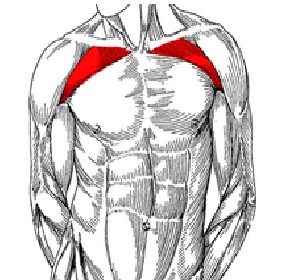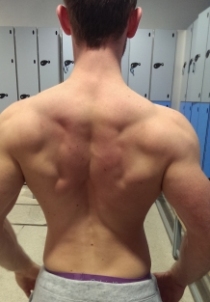Improve Your Chest Development!
Quick Tips To Building A Massive Chest!
If you’re anything like me your chest hasn’t been gifted in the genetics department. Don’t despair though; here are some tips in order to get a chest even Scott Herman himself would be envious of!
My biggest problem with the way people attack the chest is that they stick to the same exercises. Yes we all know that presses and flyes are the staple to any chest routine, but it doesn’t mean that they will stimulate the level of growth you desire if you continually practise them through the same generic movement patterns.
When training chest you have to have to remember the anatomy of the chest. The chest comprises of two muscles: pectoralis major and minor. For the purpose of bodybuilding, we must emphasise the pectoralis major. This muscle arises from two heads: the clavicular head and the sternal head. The clavicular head is commonly known as the upper chest and the sternal head is commonly known as the lower chest. (See Images 1 & 2)

The function of the pectoralis major as a whole is to horizontally adduct and internally rotate the shoulder. The clavicular head also acts to flex the shoulder from an extended position whilst the sternal head acts to extend the shoulder from a flexed position.
Tying The Anatomy Of The Chest In With The Exercises
Dumbbell Bench Press
The starting point of the dumbbell bench press is from the position of shoulder horizontal abduction, followed by a slight adduction and extension thus lengthening the pectoralis major. As we press the dumbbells, we horizontally adduct and flex the shoulder therefore activating the pectoralis major. Common mistakes with this movement are that people do not think about creating the motion of horizontal adduction when pressing which equates to more usage of the triceps. There are a few ways to overcome this:
- Think about your elbow moving in space. What I mean by this is focus on squeezing your pectorals to bring your elbows together therefore creating the motion of horizontal adduction.
- When pressing, slightly offset the dumbbells so that the change in force allows a greater force of horizontal adduction to be created.
Barbell Bench Press
The barbell bench press is similar to the dumbbell bench press as it has the same starting position therefore the pectorals are lengthened. The barbell bench press however has a limited ROM (Range Of Motion) when compared to the dumbbell bench press. But that doesn’t mean it’s an inferior exercise. Here’s how to make the bench press work:
- A huge mistake people make when bench pressing in terms of hypertrophy is that they disregard time-under-tension (TUT). A 31X0 tempo is fantastic at stimulating growth in the pectorals as it creates a lot of tension under a lengthened state which stimulates growth.
- You have to think about stimulating the pectorals in order to create and control the movement. Throughout the entire movement, think about creating horizontal adduction torsion on the bar by trying to force your hands together. This will stimulate the pectorals to work.
Dumbbell Fly
Now I’m going to be a bit controversial here and state why I do not do dumbbell flys. (I do, however, do cable flys and will explain why later).
- I don’t like the stress they put through the shoulder joints.
- It’s too easy to become internally rotated during the motion which means you are increasing the risk of shoulder injury by reducing the subacromial space and by internally rotating you are never fully lengthening the pectorals.
- The force which is created by the dumbbells only stresses the pectorals during their outer and mid-range thereby removing constant tension through a full range.
Please keep in mind that I’m not stating here that flys are bad at all! I know they work for a lot of people but for me I choose not to do them. If you’re getting results from flys keep at them! The main reason why I prefer cable flys is because they allow for constant tension to be kept on the pectorals throughout the full ROM. The nature of cables also allows for the majority of the pectorals movement patterns to be exercised.
The Full Chest
From anatomy we know we must build the sternal and clavicular head of the pectoralis major in order to create a full, even chest. In order to do this we must stress the pectoralis major from different angles. This is where incline and decline bench setup variations come into play. When you put a bench at an incline you are creating more shoulder extension. More shoulder extension equates to more clavicular head stimulation as the concentric phase of the movement requires more shoulder flexion. Work by Trebs et al (1) has shown the optimal angle for clavicular fibres recruitment to be at an incline of 44Ëš.
Studies show the decline press stimulates more fibres of the sternal head of the pectoralis major (2). Interestingly, studies also show an increase in strength when decline pressing in comparison to incline pressing (3). Flat pressing must also be included in a chest routine. Flat pressing specifically targets the sternal fibres but will also activate some clavicular fibres as well (2).
Examples Of Chest Exercises
Incline Dumbbell Press
The key point here is that I never stick with a set incline. If the clavicular head flexes the shoulder, it will be stimulated throughout the range of shoulder extension to shoulder flexion. This means I will work through any incline ranging from 15Ëš to 70Ëš. The reason I don’t go higher than 70Ëš is to keep anterior deltoid recruitment minimal. As previously mentioned I also offset the dumbbells to create more horizontal adduction force.
Flat Dumbbell Press
A variation of this exercise is hand placement. Normal dumbbell presses utilize a pronated grip. Next time you try this, use a neutral hand placement. For some people this change encourages more activation of the pectoralis major.
Decline Dumbbell Press
With this exercise I only use a small decline, around 10Ëš, as I feel this creates full activation of the sternal head.
High To Low Cable Flys
With this exercise I externally rotate the shoulder at the top of the movement and slightly internally rotate at the bottom. This adjustment takes the pectoralis major through a fuller ROM.
Low To High Cable Flyes
The focus here is creating shoulder extension then moving to shoulder flexion whilst horizontally adducting the shoulder to emphasise stimulation of the clavicular head. Always maintain a “tall” posture throughout and really squeeze the pecs at the top of the movement.
Flat Cable Flys (Middle Of Chest)
This exercise emphasises the motion of horizontal adduction. It is important to once again maintain a “tall” posture and keep a slight bend in the elbow.
Isometric Dumbbell / Plate Press
This exercise can be performed at any angle, but I prefer to use it on an incline as you can really stimulate the clavicular fibres without putting too much stress through the shoulder joints. The important factor is that you push your hands together which creates isometric horizontal adduction which will stimulate the pectorals. When utilising this exercise with an incline bench, try and keep the dumbbells / plate situated more over the clavicular fibres as this will create more stimulation.
The video shows Scott doing his “plate press.” The premise of the dumbbell press is the same as the plate press except you put two dumbbells together and press instead of using a plate.
For that traditional barbell chest press movements, see the videos below to learn proper form.
- Flat Bench Press (See Video 1)
- Decline Bench Press
- Incline Bench Press
Lastly, it is important to note that the key to making these exercises work is TUT. For hypertrophy (muscle gain) sets need to last between 40 and 60 seconds. With this in mind, the tempo I like to use is 31X0 so I normally do around 8 to 12 reps per set. On dumbbell presses, especially with a neutral grip, I sometimes like to work with a 30X2 tempo. If you really focus contracting the pectorals this tempo will really fatigue them therefore I often like to do it at the end of my pressing movements.
Working to failure is key, so I always aim to work with a weight I know I will fail with. With regards to rest periods in between sets I like to keep it at between 45 and 90 seconds maximum. Train hard Nation! #HTH #SHFAthlete
Special Note: Understanding the TEMPO in this article.
- If the TEMPO is 31X0, you would perform a 3 second eccentric, 1 second pause at the bottom of the movement, an explosive concentric (X) and then a 0 second pause at the top of the movement.
References
- Trebs AA, Brandenburg JP, and Pitney WA. An electromyography analysis of 3 muscles surrounding the shoulder joint during the performance of a chest press exercise at several angles. The Journal of Strength & Conditioning Research. 2010;24:1925-30
- Glass SC, Armstrong TY. Electromyographical acvtivity of the pectoralis muscle during incline and decline bench presses. Journal of Strength & Conditioning Research. 1997;11(3):7-75
- Leham GJ. The influence of grip width and forearm pronation/supination on upper-body myoelectric activity during the flat bench press. Journal of Strength & Conditioning Research. 2005;19(3):587-91






